Chez Megdeline
- Megan Stein
- Jun 27, 2023
- 9 min read
Updated: Dec 13, 2024
There is something wonderfully objective about designing for a client. You can see their space, their personalities, the energy of their family and glean from 1,000 feet what their interiors need to be. Designing for one's self on the other hand, can be adjacent to a personal crisis. The questions of 'who am I' and 'what do I want' 'how do I support myself at home and how do I welcome others into my home?' all loom large and the pressure to do something amazing with all that creative freedom clashes with budget and logistics.
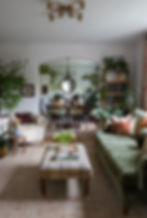
Something I find very interesting is that when given a chance to design and renovate my own home with all the professional tools I have, I fell so short of adhering to the workflow and best practises we use for Design Manifest clients! As Naomi and I have shaped that process we have spent so many hours reflecting on the client experience and adjusting our protocols, why would I not apply those in my own best interest? Lord only knows, but if you've tried designing anything for yourself then you probably know- it can get a little wild.
To start at the beginning, I bought this new-to-me home in the late summer of 2021. I had been living in my previous house, a cute 1800's twin in the heart of Fishtown for close to ten years, but like so many people the pandemic left me longing for softer, quieter greener spaces. I love plants and gardening, and I had completely maxed out my indoor plant collection and my extensive container garden in the old house. I was craving the satisfaction of being able to cultivate my own in-ground garden, wishing for more of a sense of privacy and space, better light, and I was also determined to finally fulfill my dream of having a wood burning fireplace. I found it all in a 1948 twin in Bala Cynwyd that hadn't been updated in twenty years, really ideal for a designer who wanted to have all the say in the changes and updates.
A few points of inspiration
As soon as I was under contract I drew it into our CAD software and began designing. The feeling I was channeling for this house was natural, traditional, and even a bit spare. I craved a sense of simplicity and tranquility. I knew my family of houseplants would be absolutely everywhere, as well as select pieces from my hoard of art and antique family tchochkes , so I tried to create space for all of that within my design. In the spirit of my garden dreams, my little bit of backyard meadow, and my love of 19th century literature I invented a muse for my design "the farmer who reads poetry". For every slow step along the way I would check back in with my muse; was it right for him?
As soon as I closed on the house I started the unglamorous process of having the house painted, the crumbling plaster walls patched, and wood floors refinished. I found that under the stinky pink carpet on the first floor, stairs and upstairs hallways was lovely hardwood floors.

My poet farmer muse whispered in my ear about a sofa in an "intellectual green" velvet, and after a fair bit of shopping I realized now was the time to to pony up for a lovely custom sofa in a real performance velvet that would withstand messes from my little dog (RIP Toby!) and myself. One thing interior design insiders know is that all "performance fabrics" are NOT created equal. A bit of obsessive fabric sourcing later and I had landed on my perfect green velvet. It is a bit textured which I find more forgiving than a flat velvet and has a protective treatment that repels liquids. On top of that it can be cleaned with water and mild soap, which is a must for me because honestly who wants to use dry cleaning solvents to clean upholstery? So smelly.

I chose an English roll-arm sofa from one of our favorite North Carolina-based manufacturers. The frame has a nice deep seat, which was a must as I am a cross-legged tv watcher. I was even able to customize the back rail height to fit exactly so under my windowsill. My living room rug is a handwoven jute with a subtle jacquard texture that I have been wanting to use forever. I love the contrast of the rich green velvet and the light jute rug with all its natural variation and texture.
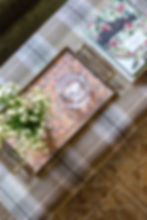
The plaid wool for my ottoman was another early selection within the design- I love the way it weaves together the green and the tan tones in the room, with just the slightest hint of mustard, and if my soul had a pattern it would probably be plaid. The little brass casters on the legs are so cute and make it easy to scoot around for vacuuming under.
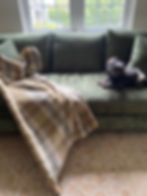
I messed around with options for my curtain fabric for the longest time, and even had different curtains up for a while, but ultimately, came back around to this blush Jacobean block-print fabric. I found, ultimately, that between the brick fireplace, the dark wood finishes and my selections for other textiles, the romantic feeling of the drapes bring creates a good balance of masculine and feminine.
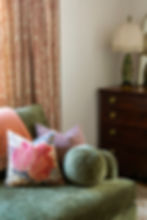
Though I love everything in my living room and feel so totally zen and relaxed in there, it really leaves space for the more dramatic moment in my home- the dining room mural. I shopped landscape mural wallpaper endlessly, but ultimately nothing was perfect- I really wanted the mural to wrap the entire room without repeating itself- just a seamless 360 degree experience. So, I dusted off my high school era art education and set to developing a palette and design for my mural. Over the course of many months of nights and weekends, my landscape mural came slowly slowly to life.

House paint, glazing medium, and an art projector, that is how.
The moon, a unicorn and a pair of swans in pearlescent paint were the finishing touches
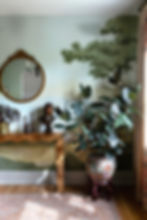
I wanted to keep the contrast and attention on the walls in this room, so I chose this lovely hand knotted rug in shades of blush and neutral. It has beautiful detail, but is subtle and the scale and motifs play a really nice supporting role to the mural.
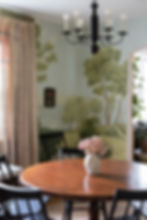
My dining curtains are made from a raw silk block printed sari that I purchased in India, back in my fashion design days when I travelled regularly overseas to buy fabrics and visit factories. I love the pattern and texture of these, and also love that they come with such a personal bit of history from my life.
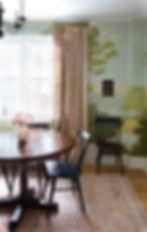

One of our favorite things to talk about at DM is "the views" from one room to the next. My house has a perfect (to me) mix of openness and defined spaces, where you can enjoy the elements of each room as they relate to one another, but each space also has its own particular story and perspective. This arch from the dining room looking into the living room (towards the front door and sun porch) frames the views coming and going from each room. The denser colors and pattern of the dining mural opens up to the lighter airier living room in a way that feels really pleasing to me. Also, shout-out to the begonias in my dining room, they really do the most to make the space feel finished.

Now, I'm really saving the biggest transformation for last as I work my way to the back of the house- that's right, it's the kitchen. When I visited my house for the first time with my realtor, I was both shocked and intrigued with how badly the space was being used in the kitchen. A wall with an arched opening split the room in two, smushing all the cabinets and the range into a small portion of the room, and allowing the fridge to hang out in the larger, empty 'eat-in' area. It was hard to understand why the space was used in this way, but easy to see that a much better layout was possible.

The first and most obvious thing was to remove the wall with the arched opening. For those wondering why I didnt just open up the kitchen to the rest of the first floor, I am not actually the hugest fan of totally open- concept living. On top of liking the experience of sequential rooms, the layout of the kitchen meant there were limits on how many walls could be used. The basement door limited use of that corner of the room, and the back wall of the kitchen included a door and a window that was too low to fit cabinetry underneath. Walls are actually a benefit when it comes to laying out cabinets!

Wall demo, laser level to prep for cabinets, cabinets mid-install
We demo'd the wall and moved the utilities that were in it (HVAC and electrical) back to the window wall. We framed out the window wall deeper to accommodate the HVAC ducts and this had the glorious side effect of giving me an extra deep window sill that is a perfect plant nursery.

I went through so many iterations on the finishes for my kitchen, which is hilarious given that I landed on a simple, classic combo of off white and stained wood. I had fallen in love with a couple of kitchens that had dramatic charcoal cabinetry, but when standing in the reality of my own space and the kind of light it got, I went with what felt right to me and what I knew I'd feel good walking into every day.

I chose white oak in a custom stain for the base cabinets, and had the wall cabinets painted in a softer off-white color. I knew I wanted to go for a really crisp white on the beadboard and pull a soft contrast on the trim and cabinetry and I'm really pleased with how they work together.

The other point of pride in my kitchen is the custom range hood I designed and had built by my most excellent GC- Andrew Stein. I spent countless hours getting the curves exactly how I wanted them, especially in relation to the wall cabinets on either side. I also spent a lot of time considering how to taper the 'legs' of the hood in a way that was graceful and wouldn't make the room feel closed in or crowded. As a finishing touch I gave the hood a coat of limewash to create a plaster texture with some variation and depth.
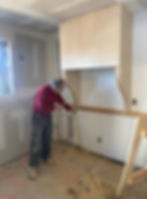
The final feature that I just love about my kitchen is the little breakfast nook I created by the back window. For much of the design process I was planning a counter and some stools for that area, but as the project progressed the vision got much clearer and I thankfully remembered that we do built-in and cozy as a matter of course here at Design Manifest. I reworked the plans slightly and added a built in bench with a little cafe table and chair to that corner. The window looks out on my back yard and is just a perfect peaceful spot to take in a slow morning. As a bonus the built in bench has a hinged lid top to add another little bit of storage to the room. With an outlet conveniently located inside the bench box, I tend to keep my battery chargers for lawn tools plugged in there- its also a great place for big packs of paper towels and dog food. s

While the upstairs of my home has received far less love and attention than the main living spaces, I have made a little progress in some of those rooms. It was important to me to get my office together, as Naomi and I do a fair amount of Zoom meetings with clients, and on days where I am making site visits I am more likely be in my home office rather than at our studio. I chose a wallpaper with an earthy soothing color palette for my Zoom wall, and refinished an antique desk I already owned to a rich dark wood stain. No comment on how the areas of my office look that Zoom can't see- nobody needs to know!
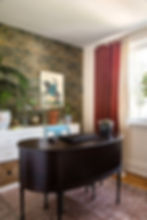
I gave some love and attention to my guest bedroom as well. I love having this welcoming space set up for guests- it makes me feel like a real grown up! The lilac and mustard plaid washed linen bedding was such a find (thank you Garnet Hill!) and I had fun playing off of those colors with the rust-hued waffle blanket and block print lumbar pillow. The vintage Turkish rug was one I'd already collected and the colors also happened to work in a really lovely way with the bedding.
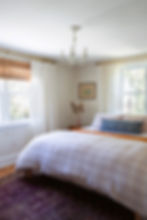
A ton of my accessories, rugs, and art are antique and vintage and the art in the shot below is no exception. The little blue painting was purchased by my Nana in Paris in the 60's, and the crazy quilt block on the wall is an exceptional piece of antique handwork that I bought for an upholstery project but found to be too pretty to do anything with but frame. Both add such nice color to the palette and just help the room feel more welcoming and finished.
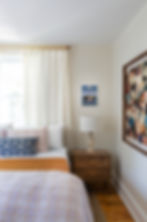
That wraps up the tour of #ChezMegdeline for now. This year I'm hard at work on the landscaping and gardens, and perhaps once they are well underway I will return to give more love to the bedrooms and the finished basement. A designer's home, after all, is always going to be a work in progress.
Photography by Courtney Apple




































